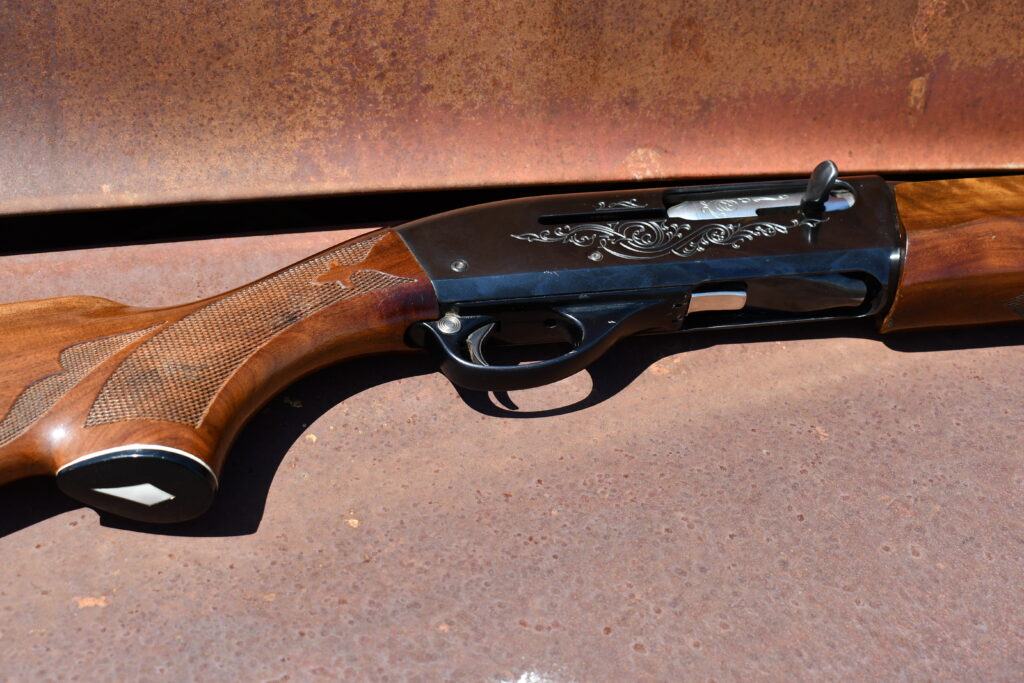I recently shared an account of my first ever experiences hunting dove in Texas on our sister publication, Athlon Outdoors. On the second day of my hunt, one of my hunting partners encouraged me to try his vintage 20 gauge Remington 1100 semi-auto shotgun. Because hunting is all about experiences, I took him up on that offer. It wasn’t before long that I had that vintage Remington shotgun up to my shoulder and ended up taking more than half of my dove limit of the day with it.
My friend’s shotgun left such an impression on me that I decided to write this. Consider it a vignette to my main dove hunting story—and an homage to the classic Remington 1100 shotgun.
I’ve never owned a 20 gauge. I still don’t. And I honestly scantly shoot them, so it seemed like a good excuse to try something different. The appeal of also using a piece of classic equipment during my first dove hunt in Texas also felt very right. Many years ago, the first shotgun I ever I fired—at 11 years old—was a 12 gauge Remington 1100 Synthetic. There’s probably a soft spot for them tucked away in the recesses of my heart.

Gas Operated Hegemony
In American shotgun genealogy, the Remington 1100 posits an interesting paradigm shift, especially when looked at historically. John Moses Browning introduced his Auto-5/Model 11 design right at the turn of the last century. Its long-stroke recoil-operated action became the definitive pattern of semi-automatic shotguns through the mid-century period.
Even Remington’s classic Model 11-48 shotgun used that long-stroke recoil action to cycle its shells, albeit in sleeker form. The mid-century period saw two models from Remington, the Model 58 and 878. As the forerunners to the 1100, these models were somewhat primitive but were an effort to move away from recoil operation and into gas-cycled actions.
The 58 and 878 had pistons inside their tubular magazines, which caused their own string of challenges—especially fouling issues. The Remington 1100 came on the scene in 1963, the same year that Stoner and Sullivan unleashed the original Armalite AR-15.
With the Remington 1100, Remington engineers implemented a pistol and sleeve design that sat independently from the tubular magazine around its circumference. Ever since, this design detail has been part and parcel of serious gas-operated semi-automatic shotguns.
It arguably became the king of gas-operated semi-auto shotguns for the better part of the end of the 20th century.
In The Hands, On The Shoulder And In The Field



Setting aside the nuances of the Remington 1100’s gas-operated action or its history, this shotgun represented a brand new blank slate for me. Sure, I own a pair of vintage pump-action Wingmasters, but neither is anything like this 1100. And neither take 20 gauge shotshells.
The shotgun I got to hunt with is a time capsule. It’s an original piece of mid-century shotgun-shooting Americana from the golden age of Remington Arms.
Like nearly every other old shotgun, its barrel has a fixed choke. The steel used in its construction, along with the steel that forms its receiver, has a deep blue finish that is seldom seen in modern shotguns.
Even though this particular specimen dates back to the mid-1960s (old enough to include a plastic butt-pad), its deep-blued finish has held up well. Even as generations of its owner’s family shouldered it to down doves over the decades.
Of course, this shotgun also wears its fair share of rubs, dings, and other marks of character. But they only make it more distinguished. Its furniture, highlighted with pretty wood grain and covered with a glossy and tough DuPont polyurethane finish derived from bowling pins, hearkens back to a time when even production-grade guns were deserving of handsome wood.
Its bolt is shiny and chrome and gleams even unintentionally in any lighting condition. I consider it the cherry on top and one of my favorite details about any vintage Remington shotgun.
Shooting the Remington 1100
I remember taking my friend’s vintage 1100 in my hands and slipping some yellow-hulled 20 gauge Federal #8 shells into its magazine—only two since we were hunting migratory birds. Despite the fact that this Remington had a full-size stock with a length of pull designed to fit an adult man, the way it balanced on the shoulder was incredible. Likewise, it was also easy to swing around as birds dropped in low and laterally over the stock tank. Even better, after pulling the trigger, it had a Goldilocks recoil impulse that was so pleasant and smooth, the opposite of violent.
If you’ve ever fired a vintage Colt AR-15, like an SP1 with its full-length rifle gas system and A1 receiver extension, that’s what shooting this old 20 gauge Remington 1100 reminded me of.
Hunting birds with a 20 gauge has its trade-offs. In exchange for a lighter gun with more pleasant recoil, one sacrifices pellet payloads and inherently increases their handicap. Wingshooting is challenging enough, and I know I want every advantage possible–especially from the extra pellets in a 12 gauge shotshell.
In the case of this old Remington 1100, shouldering it and putting some shells through it feels much like sitting down in the most comfortable spot on the couch after Thanksgiving dinner and not wanting to move.





